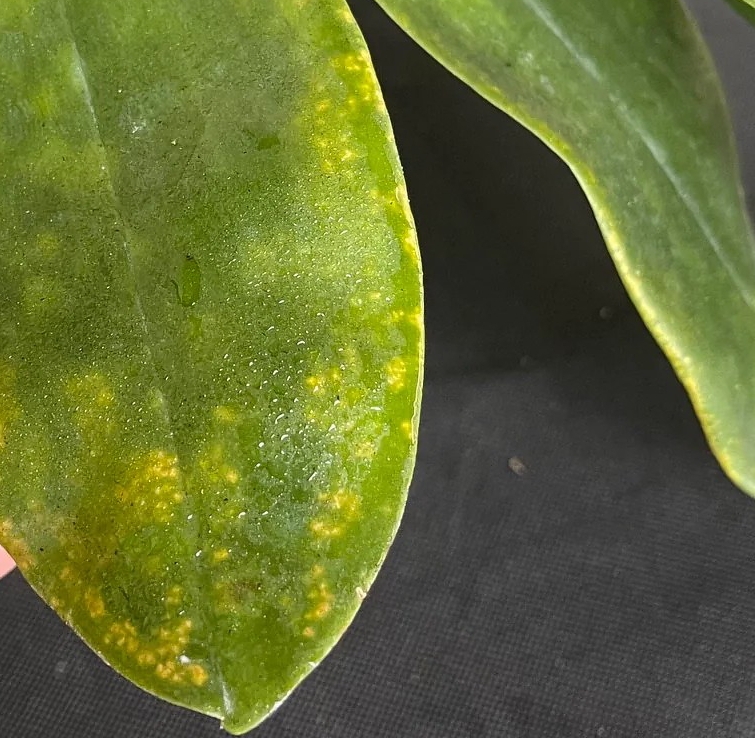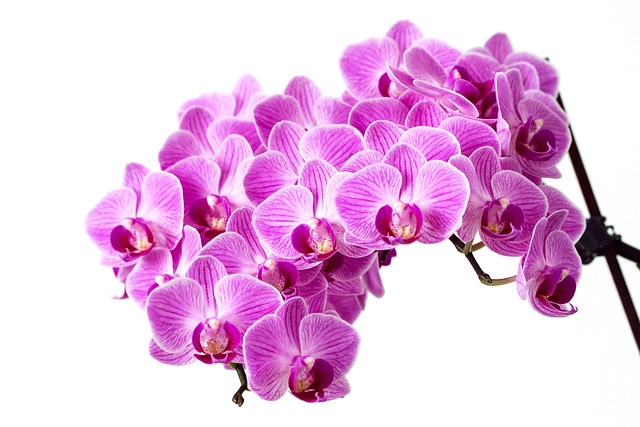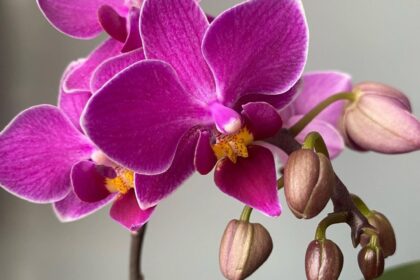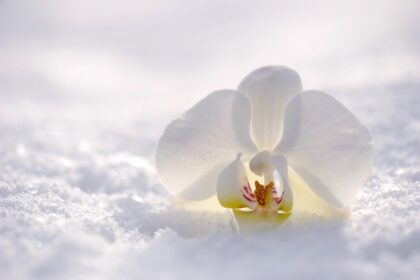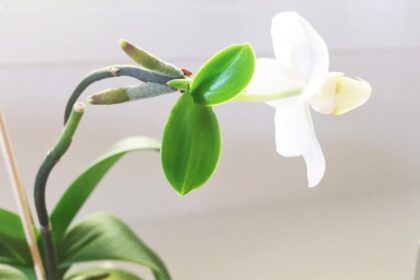Tiny yellow spots on orchid leaves can be alarming, especially when you don’t know what’s causing them. Orchids are prized for their stunning blooms and elegant foliage, but when their leaves develop unusual discoloration, it’s often a sign that something is wrong. These small yellow spots may appear suddenly or worsen over time, leaving many orchid growers frustrated and searching for answers. Whether you’re dealing with a single spot or widespread damage, identifying the root cause early can save your orchid from further stress and decline.
There are many surprising reasons why orchids develop these tiny yellow spots. Some are harmless and easy to fix, while others can indicate serious problems like fungal infections, bacterial diseases, or even pest infestations. Environmental factors such as excessive sunlight, poor air circulation, and improper watering can also contribute to the issue.
In this guide, we’ll explore 11 shocking reasons why your orchid leaves are developing yellow spots and provide practical solutions to restore their health. Whether you’re a beginner or an experienced grower, understanding these causes and fixes will help you maintain healthy, vibrant orchids for years to come.
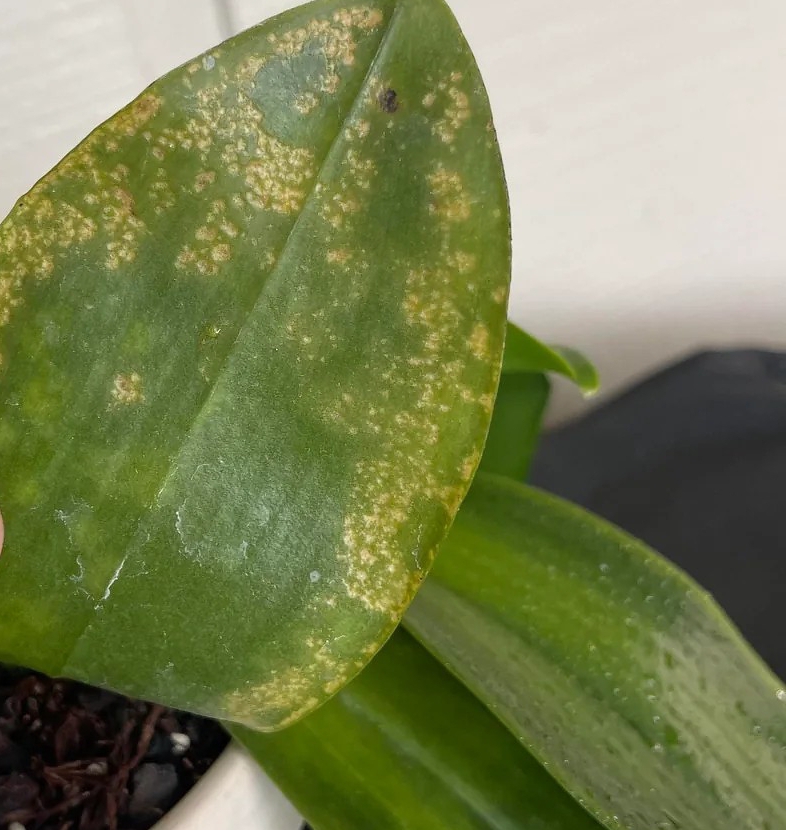
- 1 1. Spider Mites – The Destroyers of Silent Leaves
- 2 2. Sunburn – Too Much Direct Light
- 3 3. Fungal Infections – A Hidden Threat
- 4 4. Bacterial Brown Spot – A Rapid Invader
- 5 5. Nutrient Deficiencies – Lack of Essential Minerals
- 6 6. Overwatering – Root Rot’s Warning Sign
- 7 7. Hard Water and Mineral Buildup
- 8 8. Pest Infestations – Scale and Mealybugs
- 9 9. Low Humidity – Dry Air Stress
- 10 10. Chemical Burns – Fertilizer or Pesticide Overuse
- 11 11 Edema (Oedema)
- 12 what is edema (oedema)
- 13 FAQs – Tiny Yellow Spots on Orchid Leaves.
Tiny Yellow Spots on Orchid Leaves?
| Problem | Cause | Solution | Time Required |
|---|---|---|---|
| 1. Overwatering | Root rot causing stress | Reduce watering, improve drainage | 1-2 weeks |
| 2. Underwatering | Dehydration leading to spotting | Water consistently as needed | 1-2 weeks |
| 3. Too Much Direct Sunlight | Sunburn spots | Move to indirect light | Immediate |
| 4. Nutrient Deficiency | Lack of magnesium or nitrogen | Use balanced orchid fertilizer | 2-4 weeks |
| 5. Fungal Infection | Yellow patches spreading | Apply fungicide, improve airflow | 1-3 weeks |
| 6. Bacterial Infection | Wet, yellow spots with ooze | Isolate, trim leaves, treat with bactericide | 1-2 weeks |
| 7. Pests (Spider Mites, Thrips) | Tiny yellow specks, webbing | Use insecticidal soap/neem oil | 1-2 weeks |
| 8. Poor Air Circulation | Stagnant air causing stress | Improve ventilation, use a fan | Immediate |
| 9. Chemical Burns | Fertilizer or pesticide damage | Rinse leaves, use diluted solutions | 1-2 weeks |
| 10. Aging or Natural Leaf Shedding | Older leaves turning yellow | No action needed if healthy growth continues | Natural process |
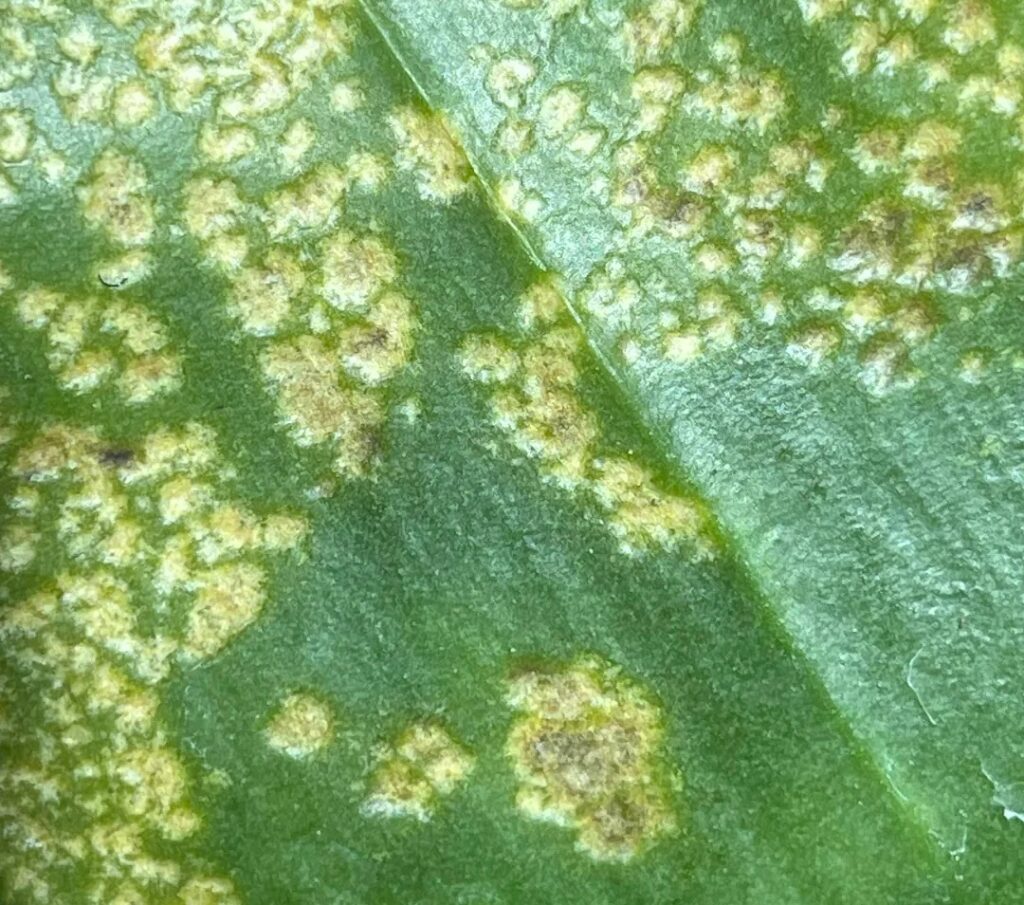
1. Spider Mites – The Destroyers of Silent Leaves
Cause: Spider mites are nearly invisible pests that feed on orchid leaves, leaving tiny yellow specks behind. These minuscule creatures thrive in dry conditions, spinning fine webs on the underside of leaves as they suck out essential nutrients. Over time, the damage accumulates, causing leaves to lose their lush green color and develop a stippled, unhealthy appearance. If not addressed quickly, a severe infestation can lead to significant leaf drop and a weakened orchid.
Fix: Increase humidity around your orchid to make the environment less favorable for spider mites. Regularly wipe the leaves with a damp cloth to remove pests and their webs. Applying insecticidal soap or neem oil can effectively eliminate mites. If the infestation is severe, consider using a miticide for targeted control.
2. Sunburn – Too Much Direct Light
Cause: Orchids need light, but excessive direct sunlight can scorch their leaves, leading to small yellow or brown spots. This usually occurs when orchids are placed in windows with intense midday sun or under artificial grow lights that are too close. Prolonged exposure to strong sunlight can weaken leaf tissues, making them more vulnerable to dehydration and further damage.
Fix: Move your orchid to a location with filtered or indirect sunlight. Using sheer curtains or placing the plant behind a larger one can help diffuse intense light. If growing orchids under artificial lights, adjust the placement to ensure they receive bright but indirect illumination to prevent burning.
3. Fungal Infections – A Hidden Threat
Cause: Fungi like Cercospora and Colletotrichum can cause yellow spotting on orchid leaves. These infections often start as tiny yellow spots that gradually grow and darken, sometimes forming sunken or watery lesions. High humidity and poor air circulation create the perfect environment for fungal spores to spread, increasing the risk of widespread damage.
Fix: Improve air circulation around your orchid by using fans or spacing plants apart to prevent overcrowding. Avoid wetting leaves when watering to reduce moisture retention, which promotes fungal growth. Treat infected plants with a fungicide, such as a copper-based spray, and remove any severely affected leaves to prevent the spread of spores.
4. Bacterial Brown Spot – A Rapid Invader
Cause: Pseudomonas bacteria create yellow spots that turn brown and mushy over time. This bacterial infection spreads quickly, especially in warm, humid conditions, and can cause entire leaves to rot if left untreated. The bacteria often enter through small cuts, insect damage, or prolonged moisture on leaf surfaces.
Fix: Isolate the affected orchid to prevent bacterial spread to nearby plants. Remove infected leaves using sterilized scissors or a sharp knife, cutting well beyond the visible damage. Apply a bactericide or cinnamon powder to the cut areas to help dry them out and prevent reinfection.To reduce the amount of moisture on leaves, avoid watering them from above.
5. Nutrient Deficiencies – Lack of Essential Minerals
Cause: A lack of essential nutrients like magnesium, iron, or nitrogen can result in yellow spots on orchid leaves. Without adequate nutrition, leaf tissues weaken, leading to patchy discoloration and slow growth. Over time, this deficiency can stunt blooming and reduce the plant’s overall vigor.
Fix: Use a balanced orchid fertilizer, such as a 20-20-20 mix, to ensure proper nutrient absorption. Supplement with Epsom salts (magnesium sulfate) once a month to provide additional magnesium. If iron deficiency is suspected, use an iron-rich fertilizer to help restore healthy green foliage.
6. Overwatering – Root Rot’s Warning Sign
Cause: Constantly wet roots suffocate and decay, affecting nutrient absorption and causing yellow leaf spots. Overwatering leads to root rot, where damaged roots fail to take up water and essential nutrients, resulting in weakened leaves that turn yellow and spotty.
Fix: Water your orchid only when the potting medium is dry about an inch below the surface. Ensure proper drainage by using a well-aerated orchid mix, such as bark or sphagnum moss. If root rot is suspected, repot your orchid in fresh media after trimming away any mushy or blackened roots.
7. Hard Water and Mineral Buildup
Cause: Tap water with high levels of chlorine, fluoride, and minerals can accumulate on leaves, leading to yellow spotting and leaf damage. Mineral deposits may also clog roots, making it difficult for orchids to absorb nutrients properly.
Fix: Use distilled or rainwater to water your orchids. If tap water is your only option, let it sit overnight to allow chlorine to evaporate. Periodically flush the potting mix with pure water to remove salt and mineral buildup.
8. Pest Infestations – Scale and Mealybugs
Cause: Scale insects and mealybugs suck nutrients from orchids, leaving behind yellow spots as damage accumulates. These pests often hide along leaf veins and stem joints, making them difficult to spot until significant harm is done.
Fix: Inspect your orchids regularly for pests.A cotton swab dipped in rubbing alcohol can be used to physically remove them. Treat infestations with neem oil or insecticidal soap, repeating applications every few days until pests are eradicated.
9. Low Humidity – Dry Air Stress
Cause: Orchids require 50-70% humidity; anything lower can lead to dry, spotty leaves. Dry air stresses the plant, causing leaves to become brittle and more susceptible to pests and diseases.
Fix: Increase humidity with a pebble tray filled with water, a humidifier, or by grouping orchids together. Misting can provide temporary relief but should not be overdone, as excess moisture can promote fungal issues.
10. Chemical Burns – Fertilizer or Pesticide Overuse
Cause: Over-fertilizing or applying harsh chemicals can cause leaf damage, appearing as yellow spotting. Too much fertilizer can lead to salt buildup, which burns delicate leaf tissues, resulting in scorched or discolored areas.
Fix: Dilute fertilizers to half strength and apply them only during active growth periods. Avoid applying pesticides or fertilizers during the hottest parts of the day to prevent chemical burns. If damage occurs, flush the plant with clean water to remove excess chemicals.
11 Edema (Oedema)
Cause: Orchids can absorb more water than they need, causing excess moisture to build up in the leaves. This leads to cell rupture, forming small yellow spots or blisters.
Fix: Improve air circulation and adjust your watering schedule. Ensure your orchid’s pot has proper drainage, and avoid watering in excessively humid conditions
Orchid Care Preventing Edema
| Care Activity | Best Time to Perform | Notes |
|---|---|---|
| Watering | Morning (7 AM – 10 AM) | Water only when the medium is slightly dry; avoid overwatering. |
| Air Circulation Check | Daily (Anytime) | Ensure fans are running or windows are open for airflow. |
| Light Exposure Check | Morning (8 AM – 12 PM) | Adjust placement to provide bright, indirect light. |
| Humidity Monitoring | Twice Daily (Morning & Evening) | Keep levels between 50-70%; avoid excessive misting. |
| Temperature Monitoring | Morning & Night | Maintain stable temperatures (65–75°F or 18–24°C). |
| Potting Mix Inspection | Weekly (Every 7 Days) | Check for breakdown; repot if it holds too much moisture. |
| Leaf Condition Check | Weekly (Every 7 Days) | Look for new yellow spots; adjust care as needed. |
| Repotting (if needed) | Every 1-2 Years (Spring) | Use well-draining bark-based media to prevent excess moisture retention. |
This routine helps regulate moisture levels and prevents edema from developing further.
what is edema (oedema)
Tiny yellow spots on orchid leaves can be a sign of edema (oedema), a condition caused by excess water uptake and poor transpiration. It happens when roots absorb more water than the leaves can release, leading to small, yellow, or translucent bumps that may later turn brown or corky.
How to Fix Orchid Edema
Adjust Watering
Reduce watering frequency and let the medium dry slightly between waterings.
Water in the morning to allow the plant to dry during the day.
mprove Air Circulation
Use a fan or open a window to enhance airflow.
Space out orchids to prevent humidity buildup.
Increase Light Exposure
Move your orchid to a brighter spot but avoid direct sunlight that can cause leaf burn.
Ensure it gets enough filtered light for healthy transpiration.
Check Humidity Levels
Keep humidity around 50–70%, using a hygrometer to monitor.
Avoid excessive misting, as it can worsen edema.
Use a Well-Draining Potting Mix
Choose bark-based media to prevent excessive moisture retention.
Repot if the medium has broken down and retains too much water.
Monitor Temperature Changes
Avoid sudden temperature drops, as cold conditions slow transpiration.
Keep orchids in a stable environment with temperatures between 65–75°F (18–24°C).
Prevent Future Issues
Ensure pots have proper drainage holes.
Use pots with breathable materials like terracotta instead of plastic.
While edema isn’t fatal, if left unchecked, it can make your orchid more vulnerable to infections. With the right care adjustments, your orchid should recover, and new leaves should grow healthy.
Yellow spots on orchid leaves may seem minor at first, but they often indicate underlying problems. By identifying the cause early and applying the correct fix, you can keep your orchids healthy and vibrant. Regular care, proper watering, and pest control are essential to preventing this issue in the future. Always monitor your orchids for changes and take swift action when needed to ensure they remain in peak condition.
FAQs – Tiny Yellow Spots on Orchid Leaves.
What causes tiny yellow spots on orchid leaves?
Tiny yellow spots on orchid leaves can be caused by pests, fungal infections, bacterial diseases, excessive sunlight, nutrient deficiencies, or overwatering. Identifying the cause early is key to preventing further damage.
How do I treat tiny yellow spots on orchid leaves?
Treatment depends on the cause. If tiny yellow spots on orchid leaves are due to pests, use insecticidal soap. For fungal issues, apply a fungicide. Adjust watering and light conditions if environmental factors are responsible.
Are tiny yellow spots on orchid leaves a sign of disease?
Yes, sometimes tiny yellow spots on orchid leaves indicate fungal or bacterial infections. If the spots spread or turn brown, isolate the plant and apply the appropriate treatment.
Can too much sun cause tiny yellow spots on orchid leaves?
Absolutely! Tiny yellow spots on orchid leaves can result from sunburn if orchids receive too much direct sunlight. Move your orchid to a bright but indirect light location.
Do pests cause tiny yellow spots on orchid leaves?
Yes, spider mites, thrips, and scale insects can cause tiny yellow spots on orchid leaves by feeding on plant tissues. Regularly inspect your orchid and use neem oil or insecticidal soap to eliminate pests.
Can overwatering lead to tiny yellow spots on orchid leaves?
Yes, overwatering can create conditions for root rot and fungal infections, leading to tiny yellow spots on orchid leaves. Ensure your orchid has proper drainage and allow the growing medium to dry slightly between waterings.
How can I prevent tiny yellow spots on orchid leaves?
To prevent tiny yellow spots on orchid leaves, maintain proper watering habits, provide adequate air circulation, use clean pots and tools, and avoid excessive fertilizer application.
Do fertilizer imbalances cause tiny yellow spots on orchid leaves?
Yes, both nutrient deficiencies and excess fertilizer can cause tiny yellow spots on orchid leaves. Use a balanced orchid fertilizer and follow recommended feeding schedules.
Can cold drafts cause tiny yellow spots on orchid leaves?
Yes, sudden temperature drops or exposure to cold drafts can stress orchids, sometimes leading to tiny yellow spots on orchid leaves. Keep your orchid in a stable, warm environment.
Will misting help prevent tiny yellow spots on orchid leaves?
Misting can increase humidity, but excessive moisture can promote fungal infections, leading to tiny yellow spots on orchid leaves. Instead, use a humidity tray for better control.
Can repotting stop tiny yellow spots on orchid leaves?
If poor drainage or contaminated soil is causing tiny yellow spots on orchid leaves, repotting in fresh orchid mix can help. Always inspect roots and remove any rotting portions.
Are tiny yellow spots on orchid leaves contagious?
If caused by fungal or bacterial infections, tiny yellow spots on orchid leaves can spread to nearby plants. Isolate affected orchids and treat them promptly.
Can improper air circulation lead to tiny yellow spots on orchid leaves?
Yes, stagnant air can encourage fungal growth, causing tiny yellow spots on orchid leaves. Ensure good airflow around your orchids using a fan or spacing plants properly
